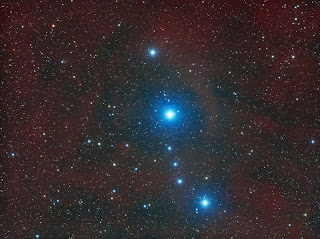Sh2-264 is a very large hydrogen rich region which is much larger than my image. It goes by many names such as Lambda Orionis Ring, Angelfish Nebula, Orion's Head Nebula, and North Orion Bubble and is located approximately 1400 light-years from Earth. An open cluster, Collinder 69, is found near the center of the nebula. The bright blue star in the center of the image, Lambda Orionis (a.k.a. Heka or Meissa), is at the center of the open cluster and is also the head of Orion. This star is also responsible for the ionization of the the nebula.
Many of my targets are planned well in advance, however, this one was selected because it was in a good location while I waited for another target. I think it turned out pretty well overall. I did have some interesting reflection problems with the LRGB data most likely due to the orientation of the telescope and the star Heka. Other than doing a lot localized processing in order to remove the reflections, the normal processing was fairly straightforward.
Dates: 1-10-21, 1-11-21, 1-16-21, 1-18-21, 1-19-21, 1-20-21
https://kurtzeppetello.smugmug.com/
http://astroquest1.blogspot.com/
https://www.astrobin.com/users/kurtzepp/collections/
http://youtube.com/c/AstroQuest1
Camera: ZWO ASI1600MM-Pro Telescope: Astro-Tech AT115EDT 115mm Refractor Telescope
Barlow: None
https://kurtzeppetello.smugmug.com/
http://astroquest1.blogspot.com/
https://www.astrobin.com/users/kurtzepp/collections/
http://youtube.com/c/AstroQuest1







